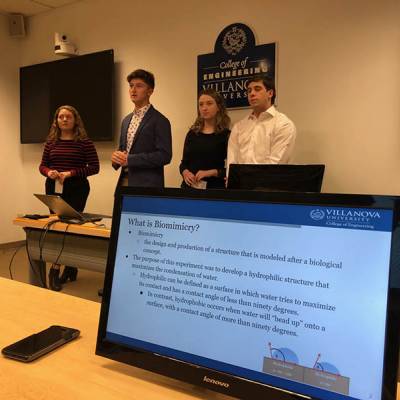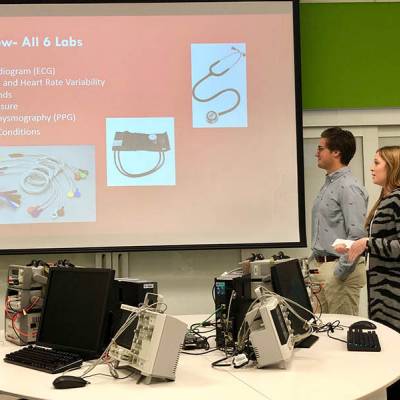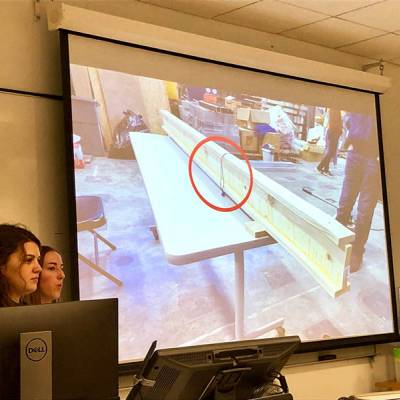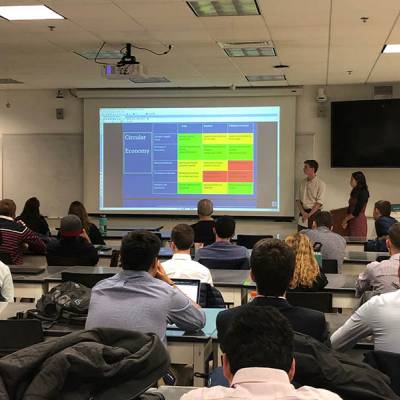Fall Semester for Engineering Freshmen Culminates in Interdisciplinary Project Presentations
Villanova engineering students begin their academic careers with the Engineering Interdisciplinary Project: an introduction to engineering analysis, design, and research for the first half of the semester and a faculty mentored interdisciplinary team project for the second half. Through this experience, freshman students are exposed to the range of engineering disciplines, and at the end of the semester teams are tasked with delivering presentations on their respective projects, providing them with invaluable experience in technical communications.
This fall, teams chose from these seven projects which they presented to audiences of fellow students, faculty and staff:
Biomimicry
The biomimicry project addresses the growing, global water-shortage crisis. While 70% of the planet is covered in water, only 3% of that water is freshwater and 66% of that water is frozen in glaciers or otherwise unavailable for use. The solution: harvesting clean water from moisture in the air. Teams integrate analysis and design concepts from physics and engineering through Solidworks design, 3D printing, and lab testing of viable surface designs. Students undertake two water harvesting tests in the latter portion of the project sequence and are required to harvest one day’s worth of water for a single person.
Biomedical Signal Analysis
Computer programming, biomedical, electrical and mechanical engineering are fused for the Biomedical Signal Analysis mini project. The project introduces the basics of anatomy and physiology, biosensor design, and signal acquisition and analysis. iWorx systems and sensors, Labscribe and Matlab allow students to develop algorithms and extract biomarkers in order to study their own hearts through bioelectric, biomechanical and bioacoustics signals.
SMARTBEAM
The SMARTBEAM mini project incorporates civil, mechanical, electrical and computer engineering in the design of a smart structure—specifically a beam. After lectures on structural elements, loads and materials, an iterative design process allows students to mathematically design and physically construct a beam outfitted with an Arduino-based strain gauge circuit and alarm, which are also built and coded by students.
Sustainable Systems Design
The Sustainable Systems Design mini project addresses all engineering disciplines at Villanova through a choice of 20 sustainable project topics and themes ranging from solar panel use to materials used in dry cleaning. Students must adopt and use a whole systems approach by considering political, economic, environmental, technological and social variables to assess the impact on the professional and personal lives of stakeholders.
DIY Spectophometer
In this mini project, students build their own colorimeter to be used in the lab to measure the kinetics of an enzymatic reaction between beta galactosidase and its substrate, ONPG. Students build an Arduino-based circuit and 3D print a part that houses a cuvette, photoresistor and LED used to measure light, which decreases as the enzymatic process turns the dye yellow. Students’ code in Arduino IDE can transfer this decreasing light into an estimate of the enzyme’s kinetic properties.
Water Energy Food Nexus
The three basic natural resources required to sustain life are water, energy and food. The three are tightly interconnected and have formed a resource and policy nexus. Students can learn about the process of making coffee while simultaneously studying energy and carbon emissions, heat and mass transfer, diffusion/extraction processes, and other forms of waste. At the end of the project, teams compete to brew the tastiest cup of coffee with the least amount of energy and carbon emissions, starting with raw beans.
Disaster Shelter
New this year with the addition of an Engineering Honors degree, the Disaster Shelter project involves Honors students in developing designs, budgets, resource allocations and siting documents for a hypothetical nation-wide disaster shelter program for the nation of Haiti. Employing a range of engineering skillsets and problem-solving strategies, the goal is to create a program that provides sustainable shelter against the ever-present threat of natural disasters. The course culminates in a live simulation that will test each team’s proposed disaster shelter plan against disaster scenarios.




